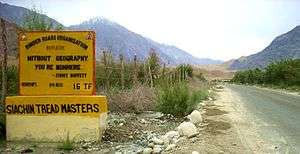Himank
Himank is a project of the Border Roads Organisation (BRO) in the Ladakh region of northernmost India that started in August 1985.[1] Himank is responsible for the construction and maintenance of roads and related infrastructure including the world's highest motorable roads across the Khardung La, Tanglang La and Chang La passes. Himank's work ensures access to sensitive military areas including the world's highest battle-ground at the Siachen Glacier and Pangong Tso Lake (at 14500 ft) whose waters span the de facto India-China border. Nicknamed “The Mountain Tamers”, Himank's personnel battling tough terrain and extreme climatic conditions and are constrained in most areas to work within a short working season of four months as roads get blocked by heavy snow and extreme cold temperatures. Between 1987 and 2002 at least 124 Himank personnel were killed while on duty in Ladakh including five officers.[2] Most of the manual labourers are from Bihar not from Ladakh. They are nicknamed Dumkas after a village where many of the original Himank workers were recruited.[3]

Historical landmarks
- Himank constructed the world's highest Bailey Bridge at Khardung La, though this has been subsequently replaced by a causeway.
- Himank's opening of the Srinagar to Leh highway in May 1999 was a crucial factor in Operation Vijay allowing India to make a timely military response in the Kargil war.
Road signs
Project HIMANK is known to have humorous road signs,[4] photos of which are the subject of the book Peep Peep Don't Sleep.[5] Examples include:

I'm curvacious, but please take me slowly.
Better Mr. Late than Late Mr.
Let your insurance policy mature before you.
On the bend go slow friend
Feel the curves : Do not test them
Darling I like you : but not so fast
Safety on road : is “safe tea” : at home
After whisky : driving risky
Don't Gossip Let Him Drive
If you are married, divorce speed
Don't be a Gama in the land of Lama.
Way of worship may be different but GOD is One.[6]
Other Himank signboards, notably those in the Nubra Valley, offer philosophical statements from those as disparate as singer Patti LaBelle, French author Jules Renard, author Jimmy Buffett and early Zionist Jessie Sampter.[7]
| Himak signboards | ||||||
|---|---|---|---|---|---|---|
|
See also
References
- ↑ BRO site
- ↑ 2002 The Tribune article
- ↑ Tribune article 2002
- ↑ This biker collects the amazing and funny road signs of Ladakh http://www.dnaindia.com/lifestyle/1884960/report-this-biker-collects-the-amazing-road-safety-signs-of-ladakh
- ↑ Amazon review of Peep Peep Don't Sleep
- ↑ Picture gallery HIMANK
- ↑ see photos
External links
| ||||||||||||||||||
